Listen to This Article
Amazon shortage claims and chargebacks are both a form of deduction faced by Amazon vendors. What are the primary differences between the two?
By unpacking the definitions, dispute processes, financial implications, and operational causes of each, we’ll take a look at what vendors are being charged and, most importantly, how those deductions can be recovered.
Key Insights
A deduction by any other name
- Though there are different types of Amazon deductions, each type can be successfully recovered.
- Amazon shortage claims arise from different circumstances than chargebacks.
- In each case Amazon provides a process for disputes.
Solutions
- Recovery rate averages of 75% are possible (with peaks reaching 99%), with an understanding of the disputes process.
- Shortage claims represent the greatest portion of total Amazon deductions.
Definitions
As with most things, a good definition helps provide clarity. Making the distinction between an Amazon shortage claim and a chargeback we can compare the two.
Amazon Shortage Claims
When you believe inventory you sent to Amazon has not been properly accounted for, you submit a shortage claim.
This typically happens when the quantity Amazon claims they received is less than what was shipped. This discrepancy in stock levels leads to a shortage.
Chargebacks
An Amazon vendor chargeback, on the other hand, has to do with compliance failure. Chargebacks are deducted from vendor payments, their primary purpose being to serve as incentive for the vendor to follow Amazon’s operational requirements and guidelines.
Chargebacks are imposed for various reasons, including:
- Late Delivery
- Carton Content Accuracy
- ASN (Advance Shipment Notifications) Errors
- Overweight/Oversized Cartons
- Import Document Issues
Financial Implications
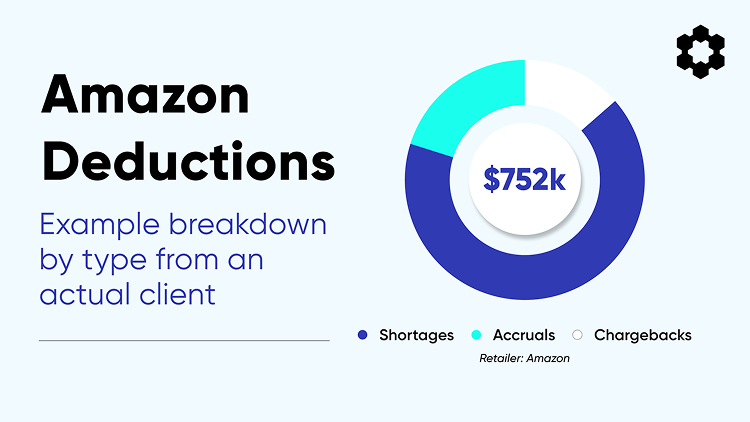
Shortage claims and chargebacks typically don’t represent a high percentage of a vendor’s revenue. Yet they add up. Any deduction is lost profit that, frankly, doesn’t need to be lost.
What to Expect
Chargeback Fees vary depending on the type and severity of the violation. These fees are typically flat amounts deducted from vendor payments per incident, while others are a percentage of the cost of goods sold.
Shortage Claims depend on the difference between the number of units received versus the number of units invoiced, with Amazon deducting that price difference from the vendor’s payment.
Fortunately, for both Amazon shortages and chargebacks, these costs can be recovered. Whether deductions occur through error on either end (with the vendor or with Amazon), or arise through some other cause, with proper documentation — and understanding — vendors are able to file a dispute and recover funds in most every case.
As an example, Carbon6 Revenue Recovery, an advanced solution specializing in 1P recovery, is able to recover an average of 75% of deductions, with recovery rates reaching as high as 99%. Which is to say, with the right techniques, high rates of success are not only possible, they become very likely.
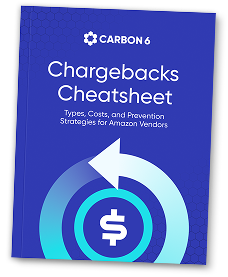
“Carbon6 has taken the frustration out of deductions resolution and equipped us with tools and insights to drive continuous improvement initiatives on the Amazon account.”
~Sanofi | Global pharmaceutical company
Filing a Dispute
Amazon initiates a shortage claim when they’re unable to match the products you shipped against receipt records at fulfillment centers. A temporary deduction is applied to the vendor account during the review process.
Before disputing a shortage, do not:
- File a dispute until Amazon’s review is complete.
- Dispute an invoice before the invoice due date. Potential shortages may be reversed before the invoice due date.
- Dispute an invoice that is already approved or paid.
- Dispute an invoice that is already being disputed (or has a draft status).
Note: The shortage dispute process can take up to 35 days or longer to complete.
How to Dispute Amazon Shortage Claims
When filing an Amazon shortage claim dispute make sure to include all the necessary information, including details of the quantities shipped, product IDs (barcodes), and the shipment date of each item.
- Go to Payments > Invoices and click Review/Dispute shortages.
- Click Actions > Dispute shortage by line item.
- Select the invoices to dispute and then complete the required fields, and click Continue.
- Add your dispute details and upload supporting documents, and click Continue.
- Review your dispute summary and click Submit or Save as draft.
Note: If you save as draft, ensure that you submit the draft later to begin the dispute process.
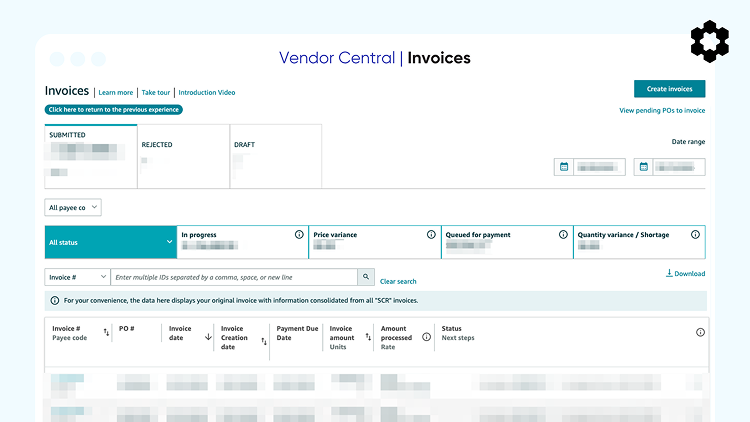
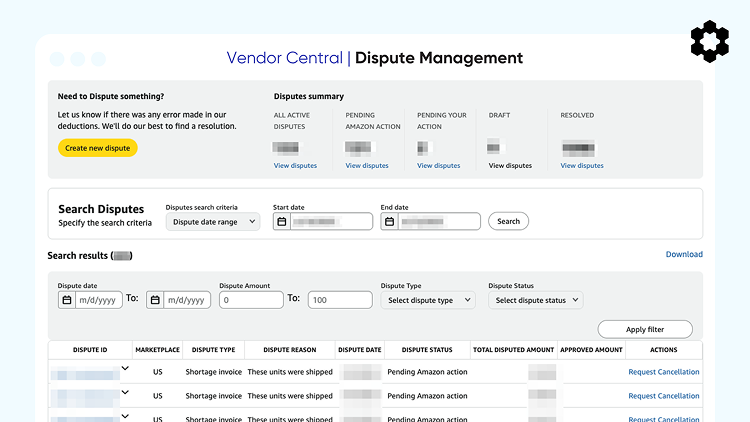
Recovering Your Revenue
If your dispute is approved, no action is required from you, and Amazon will reimburse the amount deducted.
If your dispute is rejected, you can submit a credit memo (also known as credit note) for the full or partial adjudication, depending on the outcome.
To monitor invoice shortages, go to the shortages sections of the Financial Scorecard.
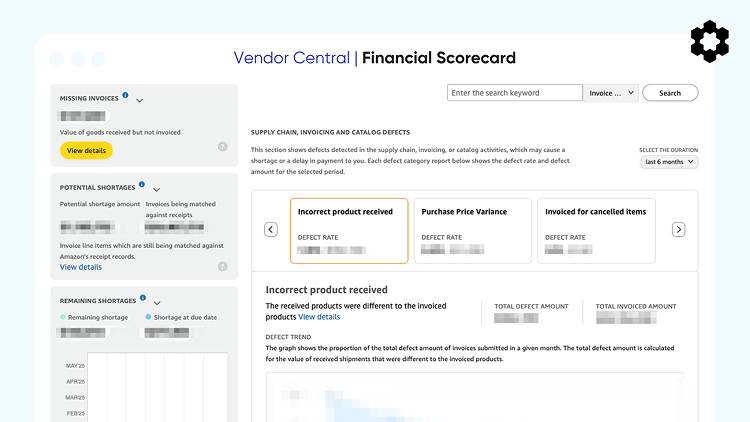
You can also submit a credit note from the Financial Dashboard by clicking In progress under Your payables. Select an invoice and choose Submit credit memo from the Available actions drop-down.
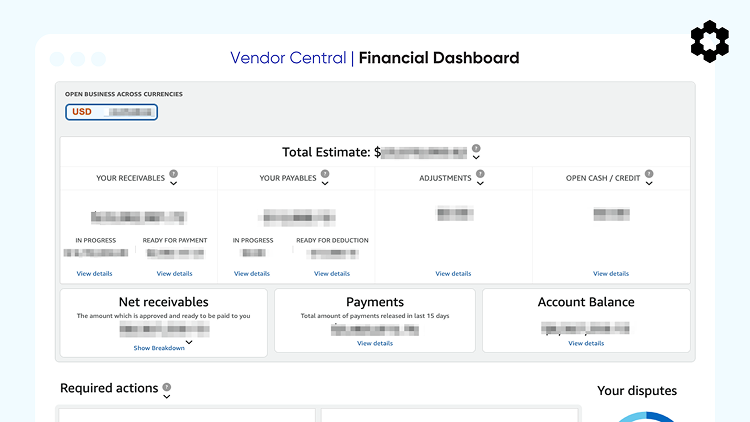
In the end, successful recovery of deductions depends on vendor diligence, thorough record-keeping, and an understanding and correct execution of Amazon’s dispute process.
Recover lost revenue from Amazon fast with a full-service solution that simplifies the complexities of 1P vendor accounting and dispute management. Explore Carbon6 Revenue Recovery.
Shortage Claim Causes and What You Can Do
What about reducing deductions in the first place?
Each dispute you don’t have to file means one deduction that wasn’t taken. Did you know shortage claims, by volume, are one of the most common deductions vendors face? In fact they’re the majority. As much as three-quarters of all deductions, on average, are shortage claims.
Causes of Amazon shortage claims include:
Catalogue Setup Errors: If you send more units than Amazon is expecting, you may be shorted those units.
Vendor Lead Time Issues: If a purchase order is canceled before the delivery is fully received and matched against an invoice, it can trigger a shortage claim.
Delivery Compliance Problems: Mistakes in shipping can lead to receipt errors.
Inbound Receiving Errors: If Amazon’s fulfillment centers miscount inventory, shortages may occur.
Loss Prevention & Damage: In the same way an overage will trigger a claim, if items are lost or damaged in transit this may also result in a claim.
Labeling & Invoicing Mistakes: These, too, can cause miscounts and trigger claims.
Everything you do, therefore, to boost your proactive approach to shipping accuracy, documentation, and dispute resolution helps. Look for and address the above common causes, and:
- Work to improve shipping accuracy
- Monitor Amazon’s fulfillment center reports to catch errors
- Keep detailed records of shipments
Reducing shortage claims is a sure way to rise above the costly cycle of deductions.
Strive for Perfection
Absolute perfection may be unattainable (okay, it’s most definitely unattainable), but you can dramatically reduce errors and oversights that end with deductions.
Even things that would seem to have little to do with deductions can influence outcomes.
Example: Poor product quality or issues with products which impact the Amazon Order Defect Rate. Such metrics can affect how Amazon evaluates a vendor’s reliability, which could mean tighter scrutiny of shortage claims, potentially leading to delayed reimbursements or disputes.
Maintaining reliability in all areas is a policy which positively affects the outcomes for your deductions.
Getting Ahead
Here’s a tip that many vendors overlook:
Leverage proof-of-delivery (POD) and freight tracking to dispute claims proactively.
Maintain strong documentation, such as signed PODs, weight verification records and carrier tracking details, then, instead of waiting for a claim, audit your received shipments using Amazon’s vendor portal and spot (and handle) issues in advance.
By catching discrepancies early, you can address them before Amazon finalizes deductions. This proactive approach reduces losses and saves hours of back-and-forth disputes.
Simplify with an Operations Partner
Managing deduction disputes and recovering funds is complicated and time intensive, yes, but with an understanding of Amazon’s guidelines and processes — and with your own processes in place to carry out monitoring, filing and tracking — you and your team can successfully recover funds that have been lost to deductions.
Of course, the best-case solution is to bring in an experienced operations partner to oversee this aspect of your enterprise for you. With 24/7 support from an expert team of recovery specialists, Carbon6 Revenue Recovery is able to achieve recovery rates as high as 99% and an average of 75%, handling the complexities of recovering your lost revenue while you focus on growing your business.
However you structure the management of vendor deductions, a strong strategy for both preventing and recovering these Amazon charges will make a difference to your bottom line.
Those Who Did
Curious how others have tackled — and prevailed against — shortage claims and chargebacks? There are many success stories from vendors who have partnered with Carbon6 to manage deductions and recover lost profits.
| Category | Challenge | Action | Results |
| Farouk Systems (Beauty/Haircare) | Losing profits due to Amazon knowledge deficit, errors in deduction tracking, no disputes filed on erroneous recoveries. | Audited vendor account, leveraged proprietary algorithms & expert knowledge, provided team training. | $1M recovered in 8 months. Increased recoveries from single-digit to double-digit net profit. |
| Global Publisher ($32M+ GMV) | Amazon’s initial settlement offer for historical lookback was significantly understated. | Applied industry expertise, advanced negotiation tactics, and focused on relationship management with Amazon. | Increased final settlement by 668% (from $95.8K to $736.1K). Recovered over $640K more than initially offered. |
| Global CPG Brand | High ongoing fees, need for historical shortage recovery, and desire to mitigate future fees. | Focused on historical recovery, ongoing disputing of new charges, and root cause analysis with supply chain coaching. | Over $2M in profit recovered in one year. Mitigated future fees by 30%. Pending multi-million dollar historical recovery. |
When it comes to strategies to take control of your fees, shortages, and accruals, Carbon6 stands ready to assist. See how we can help.
To your success.








